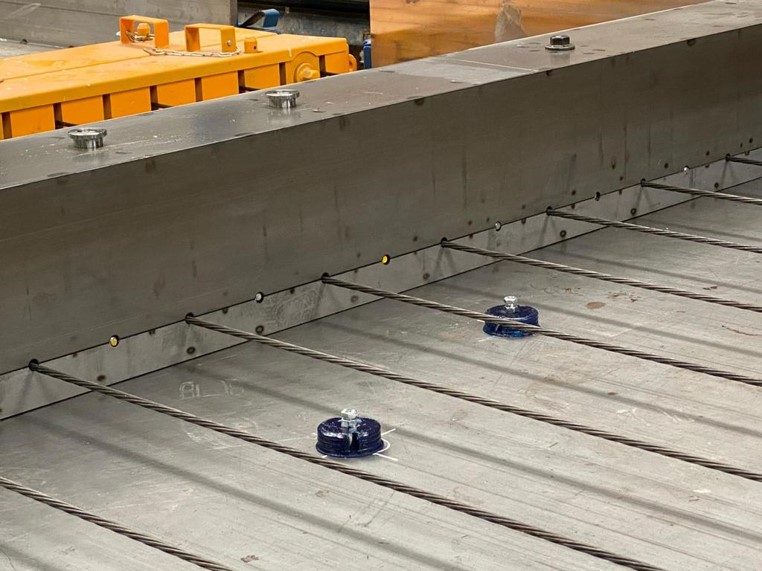Dwindling growth forecasts, strained supply chains and escalating material costs - new (and old) challenges place heavy demands on producers in the precast concrete industry. Ratec, from its base in Hockenheim, Germany, supplies shuttering solutions for precast concrete manufacturers. The company is in close contact with its customers and has its finger on the pulse of the industry.
This article shows what answers Ratec can offer with regard to contemporary core issues, whilst providing an insight into the latest innovations and advances in the field of magnetic formwork technology. Questions of sustainability, recruitment of skilled workers and market development are the most important and urgent core issues in the precast concrete industry in addition to the new, acute challenges of the past year. Ideas are needed that contribute to more resource-conserving and efficient production processes, whilst at the same time bearing quality in mind.
Material-saving formwork solutions offer answers in this regard. This also implies enhancing the durability, reusability and flexibility of shuttering components still further between different projects. A good example is the 3D mould kit developed by Ratec for manufacturing room cells. Solutions for producing flat precast concrete elements horizontally that reduce plywood and expanded polystyrene (EPS) consumption can make a significant contribution as well.
Magnet shuttering instead of EPS
One of the solutions is a recess box that scores points as a sustainable alternative to EPS. It is used for pipe and duct openings when producing girder slabs and double walls. The recess box is based on the SPB Standard Pro Magnetic Box with integrated magnet and automatic component. It is 6 degrees conical for easier stripping and can be produced with or without chamfer. Demonstrable savings of up to 60 % of EPS can be achieved with this box. Reducing the manual effort required to set up shuttering is another important aspect to consider when developing new shuttering solutions. This ensures consistent quality and less susceptibility to errors, whilst ultimately also giving greater satisfaction to the production team. Such solutions additionally enable faster processes and thus higher productivity.
Focus on reusability
One example in this area is a new window system developed on the basis of robot-compatible SAS Standard Automatic Shuttering. The SAS window system consists of SAS siderails in standard lengths of 450 mm and 1,350 mm. The siderails have integrated, switchable magnets from the company’s own production in Solingen, as well as mounting knobs that can be adapted for common shuttering robots. The siderails can be positioned by robot or by hand and supplemented by plywood pieces, that are attached to the siderails with small, easy-to-mount adapter plates. These plywood filler pieces can be reused for other intermediate spaces of identical size. As a result, the customers can dispense with EPS and work with reusable components instead. Placing the siderails by means of robot ensures correct positioning, and the plywood pieces can be added quickly and easily – an uncomplicated solution for doors and windows that can be adapted for other sizes and configurations. The solution combines automated shuttering logistics and manual labour, which provides the customer with flexibility regarding sizes, while at the same time permitting a general reduction in the use of EPS for filling shuttering gaps.
Savings on time and material
Ratec has also enhanced its expertise in the field of shuttering solutions for stationary production beds. Among other things, a transverse shuttering has been developed for producing prestressed floor elements. The shuttering is again based on SAS Standard Automatic Shuttering and consists of a base and a top part. The base part has integrated high-performance magnets and pre-formed receptacles for the strands at intervals of 250 millimetres. After prestressing the strands, the upper part of the shuttering is bolted onto the magnetically fixed base part. Both parts have gripping knobs for handling by means of a crossbeam. The base part can also be placed by robot, as appropriate gripping knobs have been arranged on the shuttering. This solution saves the customer time by allowing the shuttering to be more rapidly positioned and removed, whilst also saving on plywood.
The solutions presented as examples here demonstrate that, when new, advanced developments in the shuttering sector are thought through holistically and are closely oriented to customer needs, they often solve several problems at once, be it material savings, reusability or reduction of the manual effort for the production team. Ratec is continuously expanding its range of solutions and products in order to always have the right answer to future challenges.









